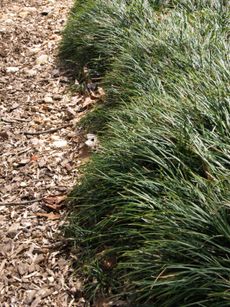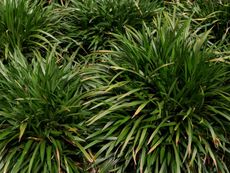What Is Monkey Grass: Caring For Monkey Grass In Lawns And Gardens


Looking for a low growing, drought tolerant turf replacement? Try growing monkey grass. What is monkey grass? Rather confusingly, monkey grass is actually the common name for two different species. Yes, things could get a little muddled here, so keep reading to learn about the different types of monkey grass and how to use monkey grass in the landscape.
What is Monkey Grass?
Monkey grass is a groundcover that looks very similar to turf grass. It is the common name for liriope (Liriope muscari), but it is also referred to as border grass. In addition, monkey grass is oftentimes used as the common name for a similar plant, dwarf mondo grass (Ophiopogon japonicus).
Are Liriope and monkey grass the same? In so far as ‘monkey grass’ is often the terminology used for liriope, then yes, which is confusing since mondo grass is also called ‘monkey grass’ and yet liriope and mondo grass are not the same at all. In fact, they aren’t even grasses.
Both are members of the Lily family. Dwarf mondo grass has thinner leaves and a finer texture than liriope. As a group, both are referred to as lilyturf.
Types of Monkey Grass
There are quite a few types of monkey grass belonging to one of two genera: Liriope or Ophiopogon. Of these varieties, the most commonly used is L. muscari, which is a clumping form. L. spicata, or creeping liriope, is best used in difficult areas such as on hillsides.
It is an aggressive spreader and should only be used in areas that need full coverage, as it will choke out other plants. Of the Ophiopogon genus, the monkey grass most commonly used is O. japonicus, or mondo grass, with fine, dark colored leaves that thrive in shaded areas.
There is also the impressive black mondo grass which adds a touch of drama to the landscape. The most popular varieties are Nana, Nippon, and Gyoku-ryu.
Gardening tips, videos, info and more delivered right to your inbox!
Sign up for the Gardening Know How newsletter today and receive a free download of our most popular eBook "How to Grow Delicious Tomatoes."
How to Use Monkey Grass
Most liriope grows to 10-18 inches (25-46 cm.) in height, although the clumping type spreads to 12-18 inches (30-46 cm.) across. This evergreen groundcover blooms from July to August with white, pink, or purple hued blooms. These spiked blossoms provide a showy contrast against the green foliage and are followed by clusters of black fruit.
Monkey grass uses for L. muscari are as a groundcover under trees or shrubs, as low edging plants along paved areas, or as the front of a foundation planting. Due to its rapacious spreading habit, monkey grass uses for L. spicata are generally restricted to use as a ground cover in areas where maximum coverage is desired.
Dwarf mondo grass is most often used as a replacement for turf grass, but may also be grown in containers or used as a stand-alone plant.
Caring for Monkey Grass
Once established, both of these “monkey grass” varieties require very little maintenance, as they’re fairly drought tolerant, pest resistant and only needs mowing or pruning once annually. In the lawn, foliage should be mowed in the late winter prior to new growth. Set the mower at its highest cutting height and take care not to injure the crown. Varieties of liriope can be divided every three or four years if additional plants are desired; however, this is not necessary.

Amy Grant has been gardening for 30 years and writing for 15. A professional chef and caterer, Amy's area of expertise is culinary gardening.
-
 "My Worst Mistake" – Gardeners Share 10 Hard-Learned Lessons
"My Worst Mistake" – Gardeners Share 10 Hard-Learned LessonsGardeners never stop learning, and sometimes our mistakes are the best teachers. But why not save time and heartache by learning from other gardeners' failures?
By Melanie Griffiths
-
 Crops for Urban Growing: 8 Edible Plants For Urban Gardens
Crops for Urban Growing: 8 Edible Plants For Urban GardensUrban edible gardening lets your yard do double duty of beauty and practicality. Have fun combining edible plants with ornamentals.
By Teo Spengler
-
 Liriope Grass Edging: How To Plant A Border Of Monkey Grass
Liriope Grass Edging: How To Plant A Border Of Monkey GrassLiriope is a tough grass that is often used as a border plant. Making a landscape border with this grass produces a tidy, low-growing, green edge that doesn't need mowing and remains green year after year. Learn more about using liriope as a border grass here.
By Bonnie L. Grant
-
 Lilyturf Cold Tolerance: How To Care For Liriope In Winter
Lilyturf Cold Tolerance: How To Care For Liriope In WinterThough evergreen, liriope in winter will naturally enter into a stage of dormancy in which growth of the plant foliage ceases. For the best results, homeowners will need to begin the process of winterizing liriope plants. Learn more in this article.
By Tonya Barnett
-
 Splitting Liriope Roots – Learn How To Divide A Liriope Plant
Splitting Liriope Roots – Learn How To Divide A Liriope PlantTolerant to both heat and humidity, lilyturf only requires minimal maintenance to continue to thrive. So what about liriope plant division? Does this plant need to be divided and, if so, how and when? Click this article for the answers to these questions.
By Tonya Barnett
-
 Monkey Grass Control: Best Way To Remove Monkey Grass
Monkey Grass Control: Best Way To Remove Monkey GrassIs monkey grass invading areas of your lawn and garden? Do you find yourself asking "How do I kill monkey grass?" You're not alone. Many people share these concerns, but don't worry. This article can help.
By Nikki Tilley
-
 How To Transplant Monkey Grass
How To Transplant Monkey GrassTransplanting monkey grass is actually pretty easy and the following article provides tips to help you learn how to transplant monkey grass in the landscape. Click here for more information.
By Heather Rhoades
-
 Information On Pruning And Cutting Monkey Grass
Information On Pruning And Cutting Monkey GrassMonkey grass is common in areas that are hilly or uneven because they fill in the area quite nicely. It comes in thick and is quite easy to grow. So easy that pruning may be necessary. Click here for pruning tips.
By Heather Rhoades
-
 Monkey Grass Disease: Crown Rot Causes Yellow Leaves
Monkey Grass Disease: Crown Rot Causes Yellow LeavesFor the most part, monkey grass is a hardy plant. But, despite the fact that monkey grass is able to take a lot of abuse, it is still susceptible to disease. One in particular is crown rot. Click here to learn more.
By Heather Rhoades